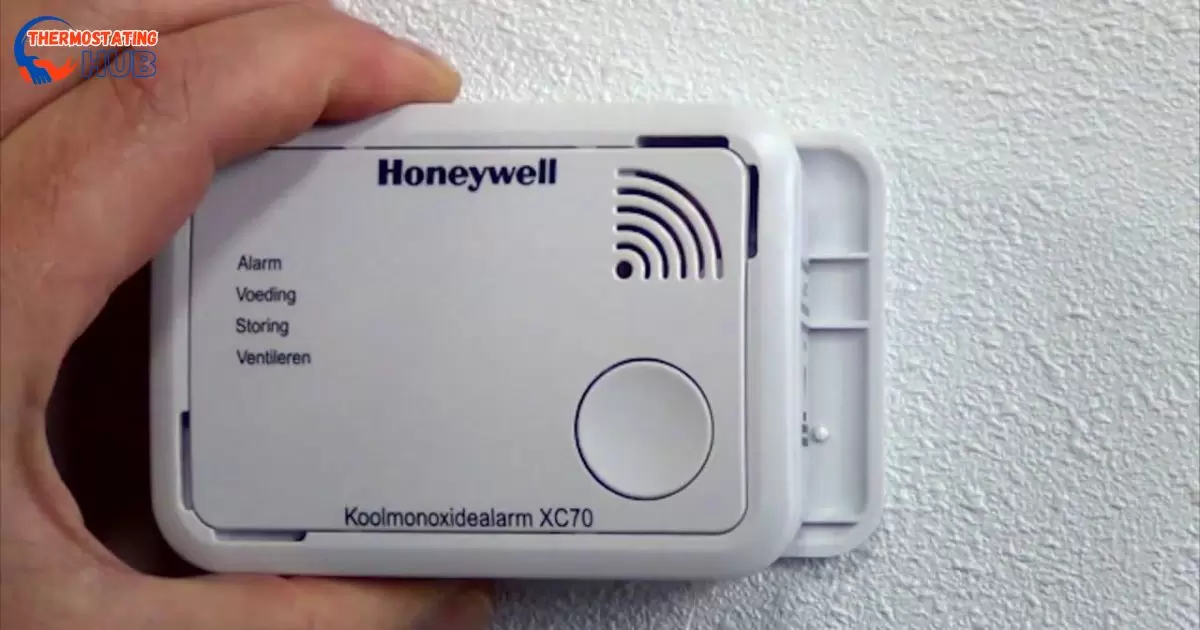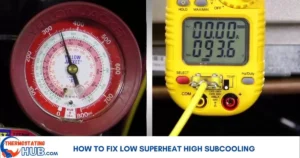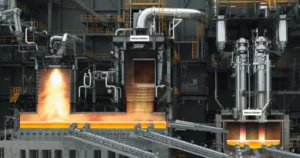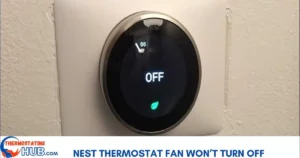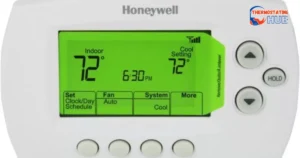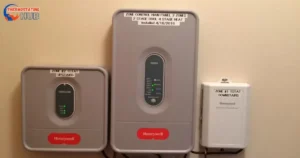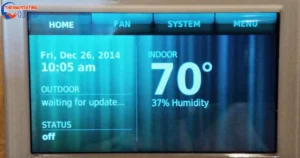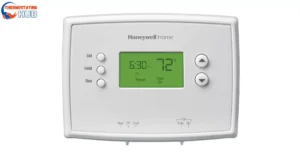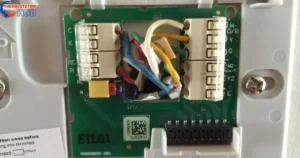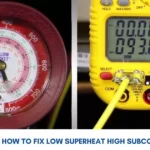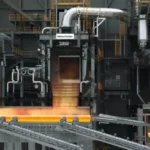If you’re curious about why there’s a red light on your Honeywell thermostat, this guide is just for you. The red light on your Honeywell thermostat can be a signal of various issues, from low battery levels to potential malfunctions in your heating or cooling system.
In this guide, we’ll explore practical steps to address the red light, providing clarity on why it might occur and how you can resolve it.
By following these straightforward instructions, you’ll be equipped to identify and fix the problem, ensuring your thermostat operates smoothly and your home remains comfortable.
Possible causes for a honeywell thermostat red light
Reasons why your Honeywell thermostat has a red light can vary. One possible cause is a low battery. If the battery is running out of power, the thermostat may display a red light as an indicator.
Another potential reason could be a wiring issue. If the thermostat’s wiring is not properly connected or there is a problem with the electrical connection, it might trigger the red light signal. Checking the battery and inspecting the wiring can help identify and address these common issues related to the red light on your Honeywell thermostat.
The Honeywell thermostat red light might pop up due to a range of common issues. Firstly, check the battery – a low battery can trigger the red light. Secondly, ensure that the heating or cooling system is functioning correctly; disruptions can also cause the red indicator. Thermostat malfunctions or wiring problems might be behind the red light signal.
This guide will help you pinpoint these possible causes and provide simple solutions to fix the issue and restore your thermostat’s normal operation.
You have manually turned on Emergency Heat
If your Honeywell thermostat shows a red light, the first thing to check is your thermostat settings. Make sure you haven’t accidentally turned on emergency heat. Many thermostats connected to zone controllers or equipment monitors use a red light to remind you when emergency heat is manually activated. This is important because emergency heat can be costly, leading to high electricity bills.
Keep in mind that if your heat pump is running in heating mode and auxiliary heat or emergency heat kicks in automatically, you probably won’t see the red light. The red light only appears when you manually activate emergency heat.
If you notice that your heating system is running differently, it could be because you manually turned on Emergency Heat. Emergency Heat is a setting on some thermostats that activates a backup heating source when the primary one isn’t working optimally.
While Emergency Heat can keep your home warm in extreme conditions, it’s more energy-intensive. It’s best to use it sparingly and revert to the regular heating mode when conditions improve. If you’re unsure about the settings, consult your thermostat manual or seek assistance to ensure efficient and cost-effective use of your heating system.
Blocked condenser unit
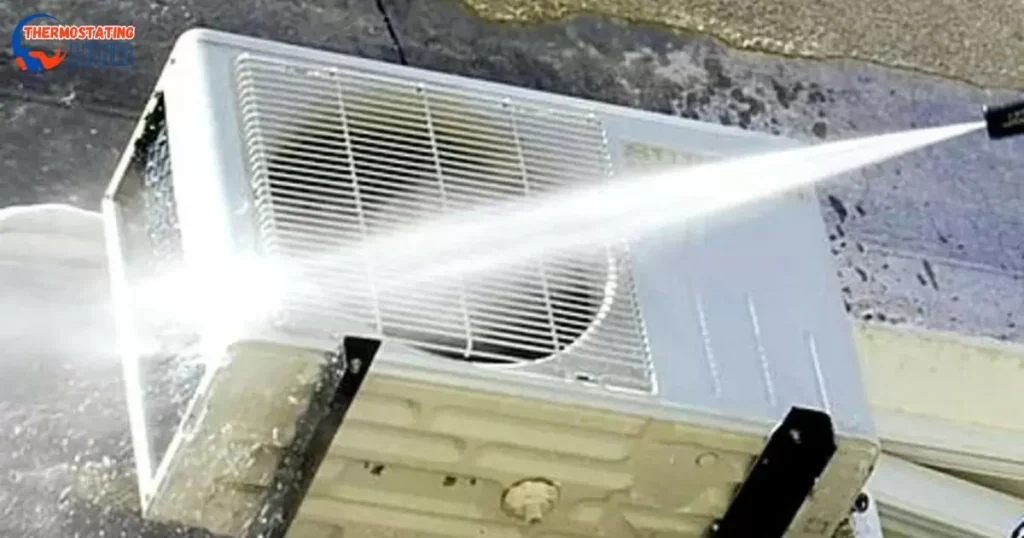
If the red LED light on your thermostat is blinking, and you didn’t manually turn on emergency heat, check if anything is blocking your outdoor AC unit. Over time, the unit can get dirty and blocked by debris
When this happens, your heat pump won’t work properly. If your system is connected to monitors, it will trigger the flashing LED light on your thermostat to alert you.
To avoid this issue, make sure to keep the AC condenser clean and free of debris. Schedule an HVAC tuneup at least twice a year to keep your system in great condition.
If the condenser is blocked (as shown in the image below), clean it and restart your AC. This should resolve the issue with the red light.
Read also: New Honeywell Thermostat Blowing Hot Air On Cool
Malfunctioning condenser fan
If your Honeywell device has a red light flashing, here are a couple of things to check. First, make sure your AC condenser unit is turning on, and the fan is spinning. If the fan isn’t spinning, it might mean there’s an issue with the fan motor, and you might need to replace it. To be sure, you can test it for continuity.
If you’re not comfortable doing that or if the condenser fan isn’t spinning, it’s a good idea to call a professional for help.
On the other hand, if the fan is working fine but you still see a red light on your Honeywell, the problem might be with the compressor capacitor.
A malfunctioning condenser fan can disrupt your air conditioning system’s performance. This fan is crucial for expelling heat from your AC unit, and when it malfunctions, it can lead to overheating and inefficient cooling.
When the condenser fan isn’t working properly, your AC may struggle to cool your home, and you might notice increased energy bills. Addressing this issue promptly by repairing or replacing the fan can restore your AC’s efficiency and keep your living space comfortable.
Defective AC capacitor
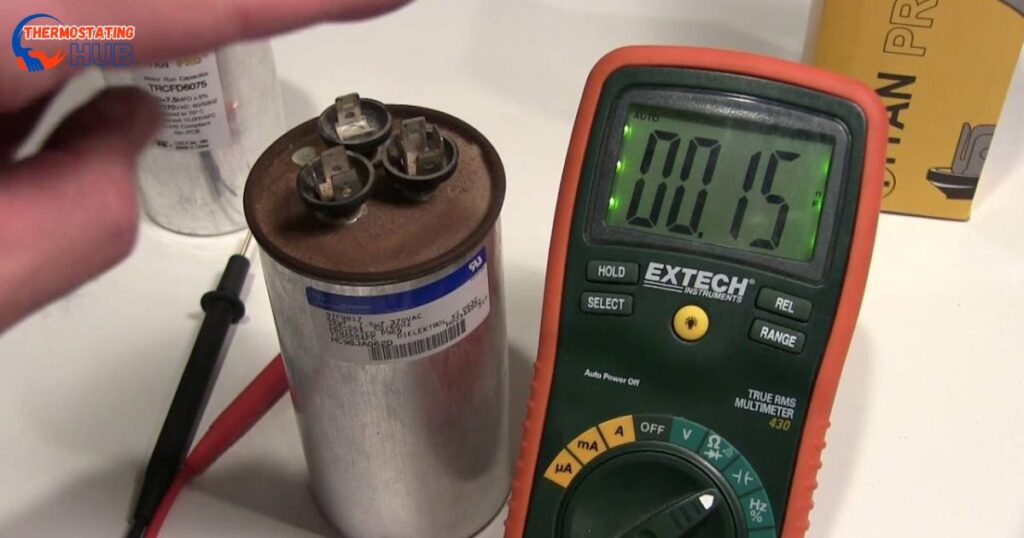
If your thermostat shows a red light, one possible reason could be a faulty capacitor. This little device helps start the compressor or fan motor in your air conditioning unit. When it’s not working, your AC won’t start. To check if the capacitor is the issue, open the outside unit (condenser) and take a look at the capacitor. Sometimes, a defective one will have a bulging top. But be careful, appearances can be deceiving.
To be sure, test the capacitor for continuity. And always make sure it’s discharged for safety, as it can store a charge that might be dangerous.
If you find a dead capacitor, don’t worry. It’s easy and inexpensive to replace. You can even buy a new one online without spending much.
Ever wondered why your AC isn’t cooling like it used to? A defective AC capacitor might be the culprit. This small but crucial component plays a big role in powering your air conditioner, and when it’s not working right, you’ll likely notice a drop in cooling performance.
The AC capacitor stores electrical energy, helping start and run the motor that drives the compressor. If it’s defective, your AC may struggle to start, make strange noises, or simply blow warm air. Luckily, replacing a faulty capacitor is a relatively common and cost-effective fix, ensuring your AC functions optimally and keeps your space cool and comfortable.
Low refrigerant
When the air conditioner’s condenser unit doesn’t have enough refrigerant, a sensor notices it and tells the thermostat. The thermostat’s red light will then turn on.
Refrigerant is crucial for your heat pump because it absorbs heat and helps move it between inside and outside. If you’re not good at fixing things yourself, I don’t suggest trying to add more refrigerant.
This is because if your system is low on refrigerant, it usually means there are leaks. Plus, you might need a special license to do it safely.It’s better to get in touch with local experts if you think your system needs more refrigerant.
Low refrigerant is a common issue in air conditioning systems. When your AC lacks enough refrigerant, it can’t cool your home effectively, leading to discomfort on hot days. Let’s explore what low refrigerant means and how it affects your cooling system.
Low refrigerant often results from leaks in the AC system. It’s crucial to address this issue promptly, as inadequate refrigerant levels can strain the compressor, potentially causing long-term damage. If you notice warm air blowing from your AC or hear hissing sounds, these could be signs of low refrigerant, and it’s wise to consult a professional to diagnose and fix the problem.
Malfunctioning AC contactor
If you see a red light blinking on your thermostat, it means the condenser unit might not be working properly. This could happen because of a problem with the AC contactor, a small device in the condenser.
The AC contactor has two contacts and an electromagnet. When the thermostat sends a 24 volt signal, it activates the electromagnet, pulling the contacts together. This connection completes a circuit, allowing the condenser to start working. So, if the red light is flashing, there might be an issue with the AC contactor or it might be stuck in the open position.
It’s not uncommon for the AC contactor to get stuck, especially if it’s been in use for a while. When this happens, it stops the condenser from turning on. When the AC contactor fails, it can make the sensor send a 24v signal to the L terminal of your Honeywell thermostat, causing the red light to come on.
If your AC contactor is defective, it’s best to replace it. They’re not expensive, and you can easily swap them out. You can find AC contactor units at stores or online. Just be sure to check the model number to get the right one.
Some homeowners might find it tricky to do this themselves and prefer hiring a professional. But if you give it a try, you could save a couple of hundred dollars.
When your air conditioner is acting up, a common culprit might be a malfunctioning AC contactor. This small but crucial component is responsible for starting and stopping the electrical current to your AC’s compressor. If it’s not functioning properly, your AC might struggle to turn on, stay on, or turn off when needed, leading to potential cooling issues.
Wondering if your AC contactor is the culprit? Look out for signs like frequent cycling, strange noises, or the AC not responding to temperature adjustments. If you notice any of these issues, it’s worth checking the AC contactor for wear or damage and considering a replacement if needed.
Read also: Honeywell Thermostat From Celsius To Fahrenheit
Benefits Of Honeywell Thermostat Red Light
The Honeywell Thermostat Red Light offers several benefits for users. Firstly, it serves as a visual indicator, quickly alerting homeowners to potential issues with their heating or cooling systems. This helps users identify problems promptly, allowing for timely troubleshooting and maintenance.
The red light feature enhances energy efficiency. By promptly addressing issues signaled by the red light, users can optimize their HVAC system’s performance, preventing energy waste and promoting a more cost-effective and environmentally friendly home climate control.
Pros And Cons
| Pros | Cons |
| Provides clear guidance on fixing red light | May not cover all possible thermostat issues |
| Easy-to-follow steps for troubleshooting | Specific solutions may not work for everyone |
| Helpful for Honeywell thermostat users | Lack of in-depth technical explanations |
| Simplifies the process for non-technical users | Limited information on when to seek professional help |
Answers To Key Questions
Why is my Honeywell thermostat red light?
The red light on your Honeywell thermostat could indicate various issues like low battery, heating or cooling problems, or a malfunction.
What does red mean on a thermostat?
A red light on a thermostat typically signals a problem, such as low battery, heating/cooling issues, or a malfunction that needs attention.
Why is my AC showing a red light?
The red light on your AC may indicate issues like a malfunctioning thermostat, low refrigerant levels, or a problem with the cooling system that requires inspection.
Why is the red light on my Honeywell relay box?
The red light on your Honeywell relay box could signal issues with the HVAC system, indicating a need for troubleshooting or professional assistance.
Final Thoughts on Fixing a Honeywell Thermostat red Light
Troubleshooting the Honeywell Thermostat Red Light is a manageable task with the right guidance. By following the simple steps outlined in this guide, you can swiftly address issues related to the red light indicator on your thermostat.
Remember, timely attention to the red light can help prevent potential heating or cooling problems, contributing to both energy efficiency and cost savings. Whether you’re a seasoned DIY enthusiast or someone new to thermostat maintenance, these user-friendly solutions empower you to keep your home climate control system running smoothly.
Stay proactive, follow the steps, and enjoy a comfortably regulated home environment with your Honeywell thermostat.

I’m Dariel Campbell, the HVAC maestro at thermostatinghub.com. I’m not just about fixing air conditioners; I’m your cooling confidant. As a problem-solving storyteller, I dive into the world of HVAC with a passion for unraveling dilemmas. Join me on a journey where your comfort is the plot twist we’re all waiting for!
